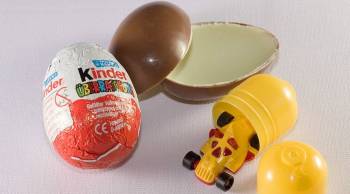
One of China’s hottest toys sold millions. The inventor made $830.
One of China’s hottest toys sold millions. The inventor made $830.

College student Zhou Wenhao studies marine engineering in the central Chinese city of Wuhan by day. By night, he tinkers with 3D printing machines.
In the summer of 2022, he printed a green and white toy switchblade smaller than the palm of his hand. Zhou named it “carrot knife” because the blade was orange.
A year passed before the carrot knife became the hottest-selling toy among school children across China.
“One agent manufactured 100,000 carrot knives a day during the peak. I estimate that about 10 million to 100 million were sold,” Zhou said. “I sold about 400 to 500 pieces.”
Like many thousands of toys found on Amazon, the carrot knife has no brand or big company behind it. Much like the hoverboard in 2015 and fidget spinners in 2017, these toy fads are driven by the efficiency and competitiveness of the Chinese manufacturing ecosystem, sometimes at the expense of the inventor.
The carrot knife trend got off to a slow start. In June 2022, Zhou posted an eight-second clip of the carrot knife on the Chinese video-sharing platform Bilibili, where he said 3D printer fans usually show off their designs.

“In the first two weeks, the video didn’t get much traction. Then it attracted hundreds of thousands of views, and I sold a couple hundred carrot knives,” Zhou said.
Orders started to fizzle. Zhou moved on to another 3D printing design: butterfly knives shaped like carrots and bananas.
A year later, at the urging of a friend, Zhou uploaded his product videos again, but this time on TikTok’s Chinese sister site, Douyin.
“The carrot knife video got around 5 million views. Then some manufacturers started hyping the toy. They started posting their own carrot knife videos that had even more views than mine,” Zhou said.
Among them was toy manufacturer and seller Yu Pinghai.
“When I first saw the carrot knife, I thought it was a good toy,” Yu said, adding that he is always on the lookout for the next hot toy.


He wanted to copy the carrot knife, though he hesitated at first because the design seemed too easy to replicate.
“If the technical barrier is very low, there would be lots of other imitators and the price would go down till there would be no profits. I didn’t want to join the price war. So, I normally wouldn’t do it,” Yu said.
But he didn’t have any other product on hand, so he copied the carrot knife design.
“It was just a coincidence and luck that I became the first group [to manufacture the carrot knife] and sold a lot,” he said.
He did not disclose how many he sold, but on his Douyin account, one video last September showed carrot knives at his factory carried the caption: “I thought I would manufacture the carrot knife for only a month, but now I’m selling 90,000 pieces a day, and it still isn’t enough to meet demand.”
Yu is based in Yiwu city, a manufacturing hub that produces most of the world’s Christmas decorations and trinkets.
Spot the difference: Two near-identical carrot knives. On the left is Zhou Wenhao’s original 3D-printed knife. On the right is a copy from a Yiwu factory, which Zhou said feels lighter and has a blade that doesn’t glide out as smoothly. (Jennifer Pak/Marketplace)
“When the carrot knife went viral, manufacturers and sellers in Yiwu didn’t care about copyright,” Zhou said. “Yiwu has the production capacity but is thirsty for good ideas.”
Some manufacturers got in touch with Zhou to work together, while many more just reproduced his design. At first, it didn’t bother Zhou because he was busy with orders for another one of his designs — the banana-shaped butterfly knife — which he thought was going to be the real hit. Plus, he had only one 3D printer at the time.
“I had no time for new orders. Besides, I thought the carrot knife was an old product and would not last long in the market,” Zhou said.
He may have been reluctant, but a lot of manufacturers, especially in Yiwu, forged ahead.
Last summer, carrot knives were all the rage among elementary and junior high students in China — a customer base Zhou did not consider targeting.
“Companies in Yiwu have their distribution channels. The toys in the shops near elementary schools were all made by them,” Zhou said. “They could make it at a price suitable for those students.”
Zhou’s carrot knives retailed at 30 yuan, or $4; those made in Yiwu were initially sold for one-third the price or less.

“Now the price is about 3 yuan [40 cents] to 5 yuan [70 cents] a piece,” Zhou said, adding that this is possible when Yiwu’s factory costs are just 10 cents apiece.
Yiwu is skilled in plastic injection molding.
“From making molds, manufacturing, and logistics, it is all concentrated in one area. That is why Yiwu’s production cost is so cheap,” Zhou said.
These industrial clusters are the reason there are a lot of cheap toys overseas on sites like Amazon and Wish. Chinese factories make money by selling in volume. They encourage repeat buying by updating the carrot knife design, such as adding glitter water, making the toy glow in the dark and producing big ones the size of a cereal box.

“In the Yiwu business circle, information spreads fast,” toy manufacturer Yu said. “Production of the carrot knife lasted two to three months. Each design variation was popular for seven to 10 days.”
Marketplace showed Zhou a carrot knife purchased online that looked similar in size and shape to the one he makes.
“The copycat is too light compared to mine, and the quality is not good,” he said, adding that this would affect how smoothly the blade glides out.
Carrot knife sales hit a snag last fall. Local news quoted experts who said the plastic blades could hurt young children and that it is an exaggeration to say the carrot knife helps students relieve stress.
“I saw a lot of people refute this claim [that the carrot knife could be dangerous] online,” Yu said. “But these concerns did affect the popularity of the carrot knife, and we stopped selling them.”
Zhou, the inventor, collaborated with a non-Yiwu-based Chinese factory at one point. However, he was told one of the partners absconded with the factory’s money. Zhou has not received any money from the manufacturer.
“[In the end] I earned about 5,000 yuan [$690] to 6,000 yuan [$830] in profits from selling the carrot knife,” Zhou said.
He doesn’t think a patent would’ve helped him.
“In the internet era, things can be easily amplified, but things that come fast can go just as fast,” Zhou said. “The best way to earn money from an invention is not by applying for a patent, but to manufacture and sell the product yourself.”
He also needs to avoid getting swallowed up by China’s manufacturing machine.
Additional research by Charles Zhang
There’s a lot happening in the world. Through it all, Marketplace is here for you.
You rely on Marketplace to break down the world’s events and tell you how it affects you in a fact-based, approachable way. We rely on your financial support to keep making that possible.
Your donation today powers the independent journalism that you rely on. For just $5/month, you can help sustain Marketplace so we can keep reporting on the things that matter to you.

















